2022 Ducati Streetfighter V2 Review
Motorcycle Test by Rennie Scaysbrook
It’s a tried and true recipe: make one really good thing, then scale it to make another really good thing, and so on. Motorcycle manufacturers have been doing this for years (think every superbike/supersport combo imaginable), but we haven’t seen it happen all that often in the performance nakedbike sector.
This is mainly because nakedbikes don’t follow a set rule book. They can be… whatever. It’s that individuality that makes them appealing, so to see an almost straight aesthetic copy of one machine to another, especially in the performance nakedbike category, is rather unusual.
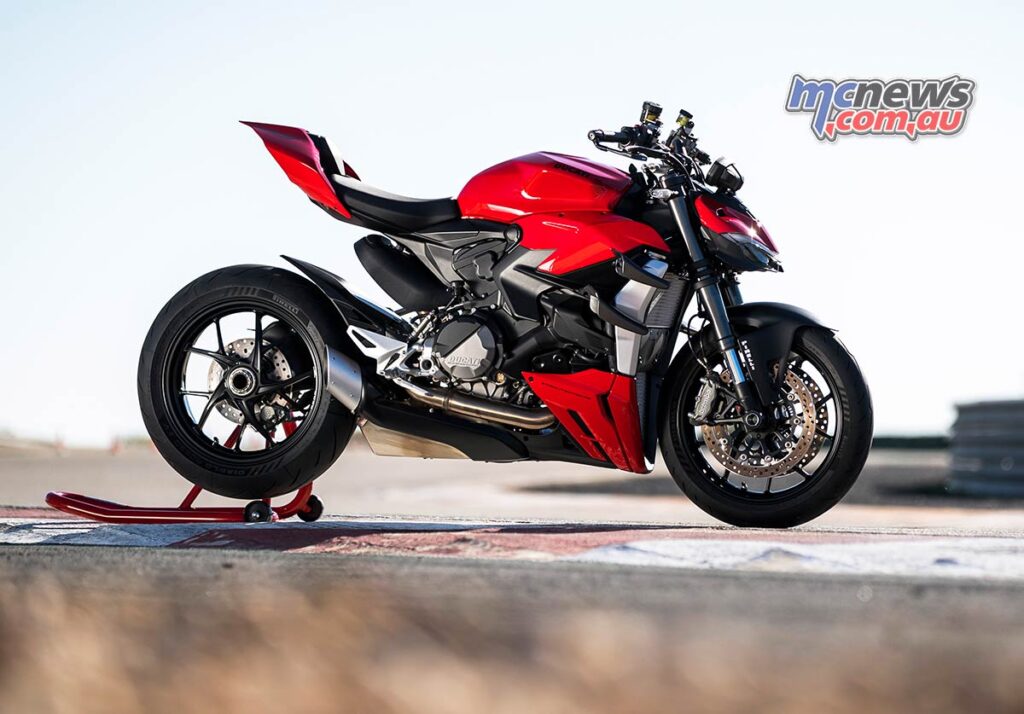
It’s ok if it’s from your own gene pool, though. And Ducati has a fine one from which to draw upon its latest and greatest.
The 2022 Ducati Streetfighter V2 is, however, far from just a rolling tribute to the bonkers V4. More approachable, accessible and not quite as license-annihilating as the V4, the 153 hp V2 is Ducati’s jab at bikes like Yamaha’s venerable MT-09 and KTM’s 890 Duke, two bikes I personally love and the latter of which I feel is extremely underrated.
Like the V4, the V2 is essentially a Panigale stripped of what makes it a Panigale. It’s got the same Superquadro 90-degree L-twin motor, a slightly revised chassis that includes a 16 mm longer swingarm for better braking and acceleration stability, and the same 43 mm Showa Big Piston Fork and fully-adjustable monoshock.
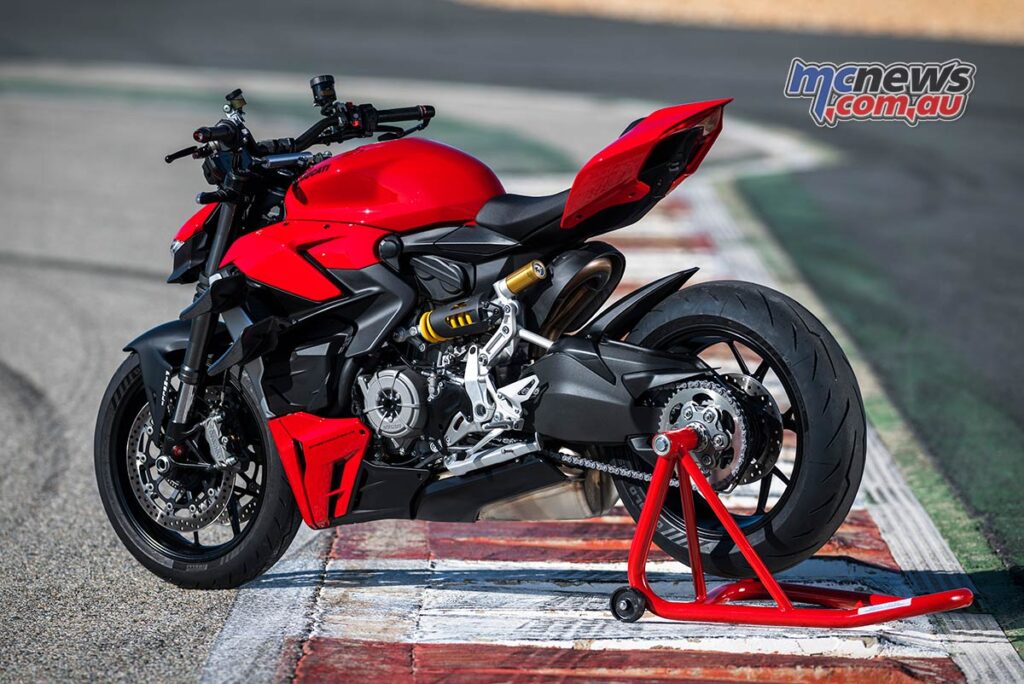
Brembo’s M4.32 four-piston monobloc caliper mates to a Brembo radial 18mm master-cylinder and Cornering ABS is there to save your hide (to a degree) if it starts to go pear-shaped.
The V2 also comes with a revised rider seat that’s flatter, thicker and wider, and the class’s ubiquitous single-piece handlebar replaces the racy clip-ons of the Panigale.
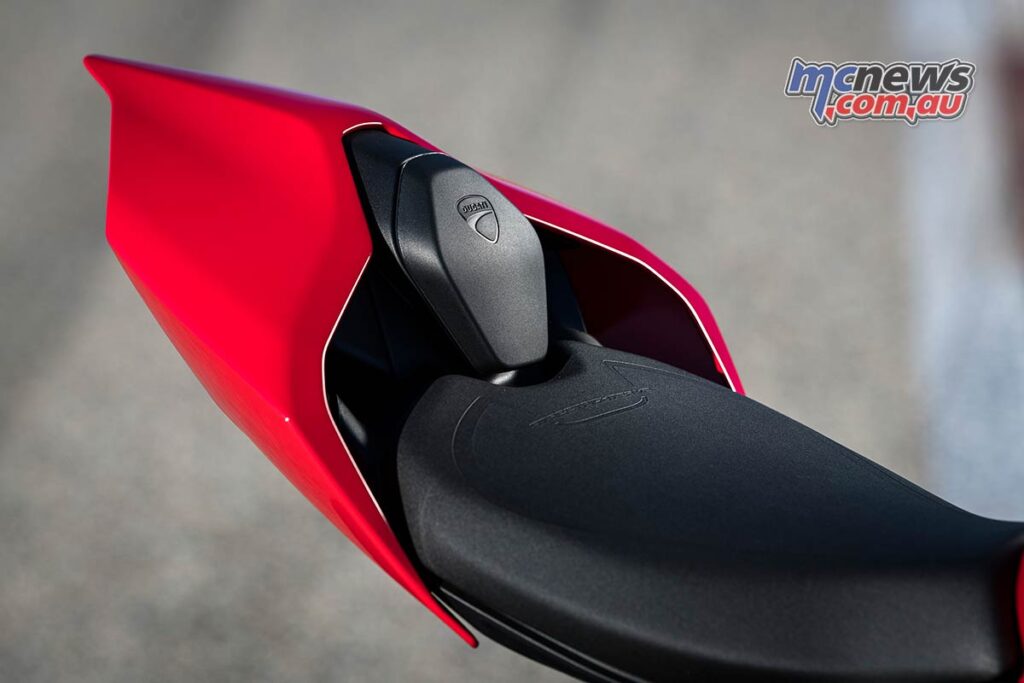
What the Streetfighter hasn’t got is the acres of bodywork, any form of wind protection and, curiously, no cruise control (it isn’t even available as an optional extra).
In standard form the V2 doesn’t come with winglets but you’ll notice from the track session photos there are indeed wings on my V2. These are from the Ducati accessory catalogue and come in either plastic or carbon-fibre, but I suspect more people will be buying the wings for the attention factor than any performance gain, regardless of the chosen material.
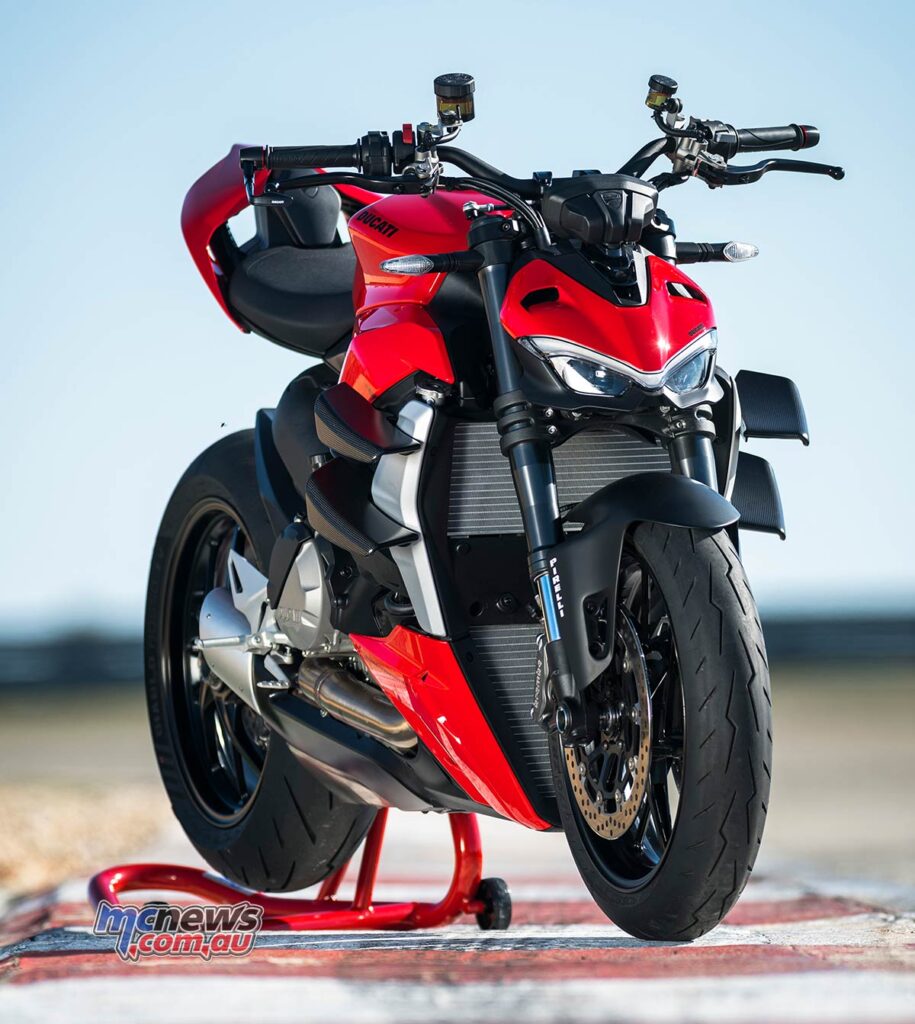
If you were to put the V2 and the V4 side-by-side, you’d be hard pressed to spot the initial difference. The same Joker-style face is glaring back at you with the LED light emitting a snarling, guilty smile, and the sharp tail unit, a hangover from the Panigale, gives the Streetfighter an unmistakable stance.
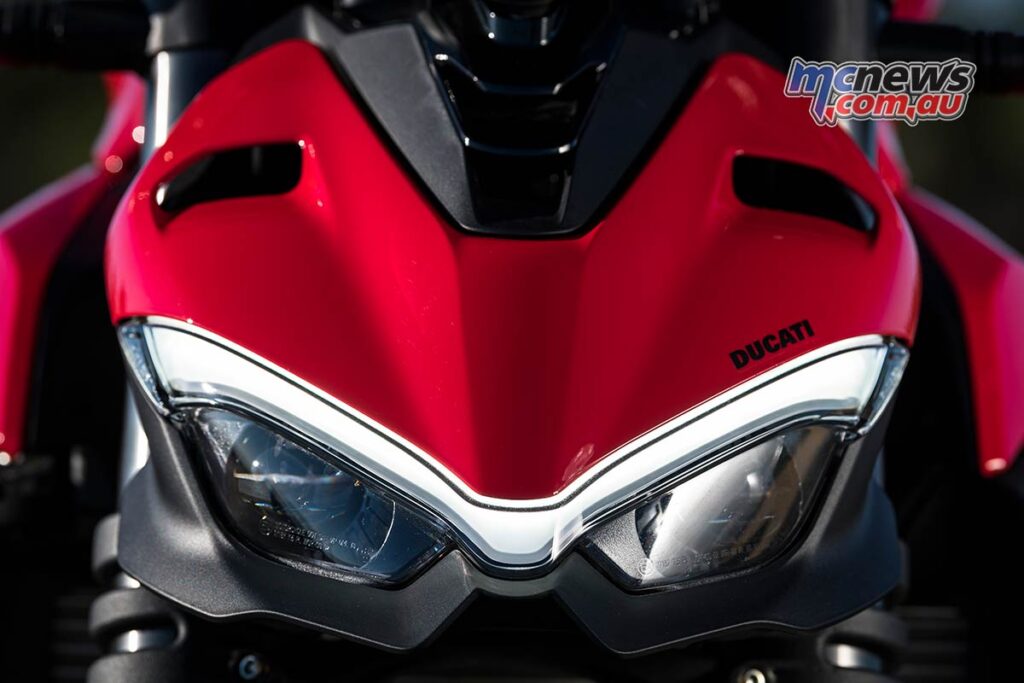
The electronics are as you’d expect for a modern Ducati and a sporting one at that. Three riding modes in Sport, Road and Rain, each with its own ride-by-wire setting, a Bosch IMU, eight stage traction control, four-stage wheelie control, up and down quick shifter, three-stage Cornering ABS and three-stage Engine Brake Control are all at your fingertips, as is the Slide-By-Brake ABS mode that allows you to do your best Pecco Bagnaia impersonation by backing it into corners (on the track, of course).
It’s all accessed via the compact 4.3-inch TFT display, which in this day of massive seven-plus inch dash units feels rather small. Despite this, it’s easy enough to read but like phones, once you get used to a big screen, it’s hard to go back.
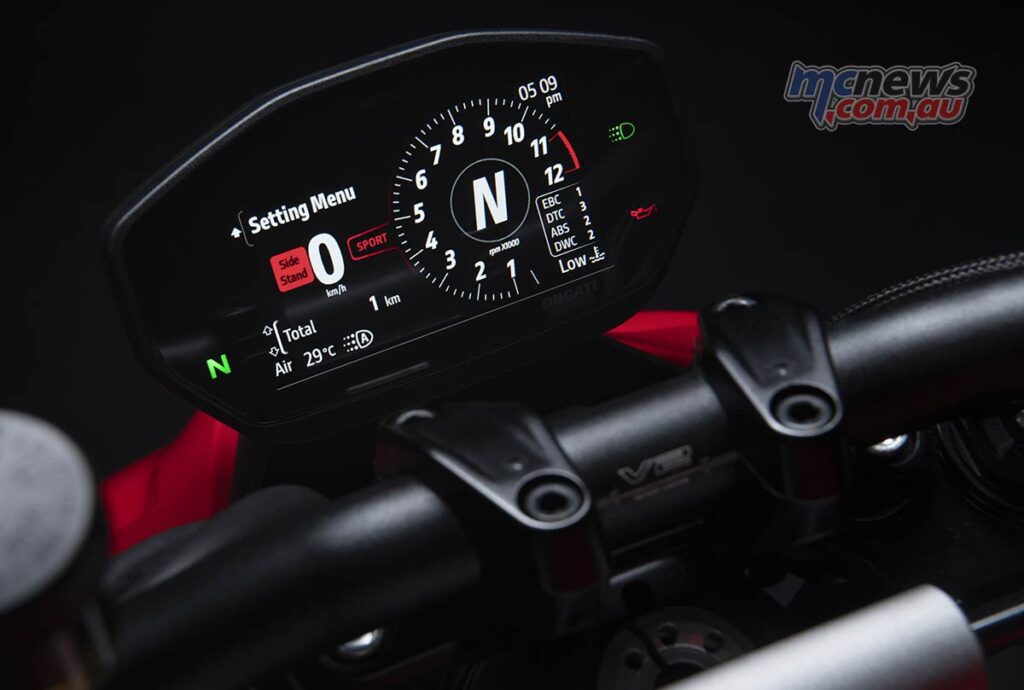
Speaking of going back, this was the first international launch I had attended since the ’Rona decided to burn life down as we knew it, and Spain was once again chosen as the venue for Ducati to get back to the business of making their bikes look as fancy as possible.
If you’ve ever wondered why bike manufacturers do launches in the first place, rather than just give the bikes to the respective publications, it’s because they can control the narrative to some degree. They provide the photos, make the bike look all pretty, and you get access to the bike’s development staff. You can’t control the narrative as well when the bike is out of your control, and I think you’ll agree, Ducati did a better job on the photos than I could with my phone…
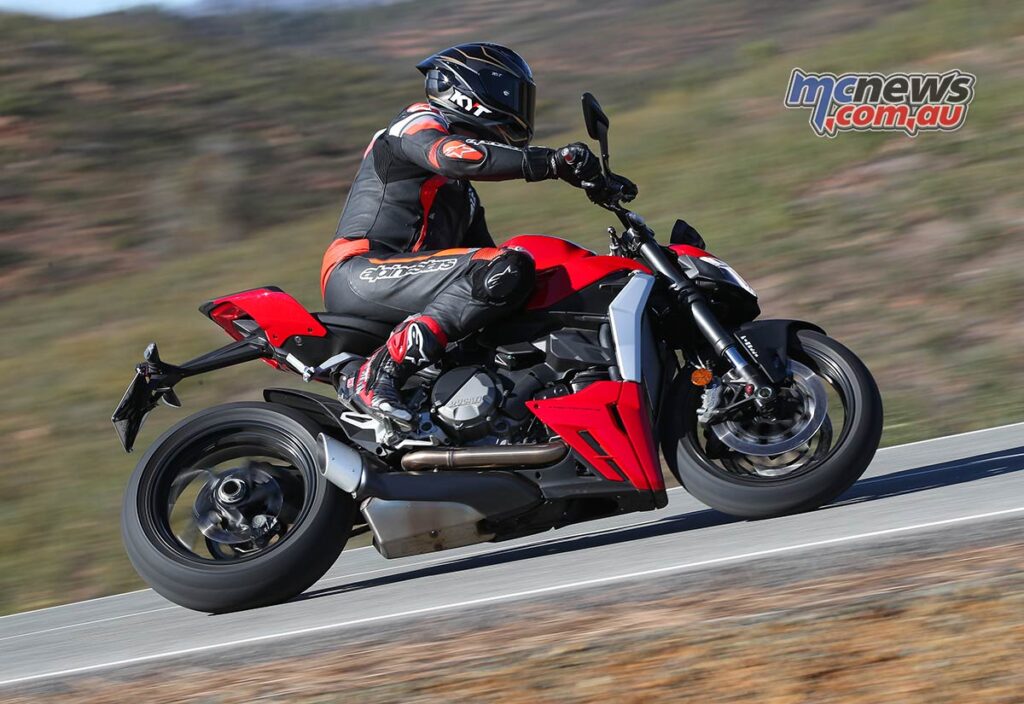
The Circuito Monteblanco and the rolling hills surrounding the track, about 45 minutes south west of the glorious Spanish city of Seville, hosted the launch. Monteblanco is a circuit more famous as the haunt for the British Superbike teams to escape the Blighty winter for a few test miles, and is an excellent venue for streetbike testing as it’s got a near perfect mix of fast, slow, blind, and cambered corners, plus a massive straight to max the thing out on.
I’ve ridden my fair share of Ducati 959/V2 Panigale’s over the last five years and have become a staunch fan of the platform, so testing out the Streetfighter version on track first threw up a few surprises.
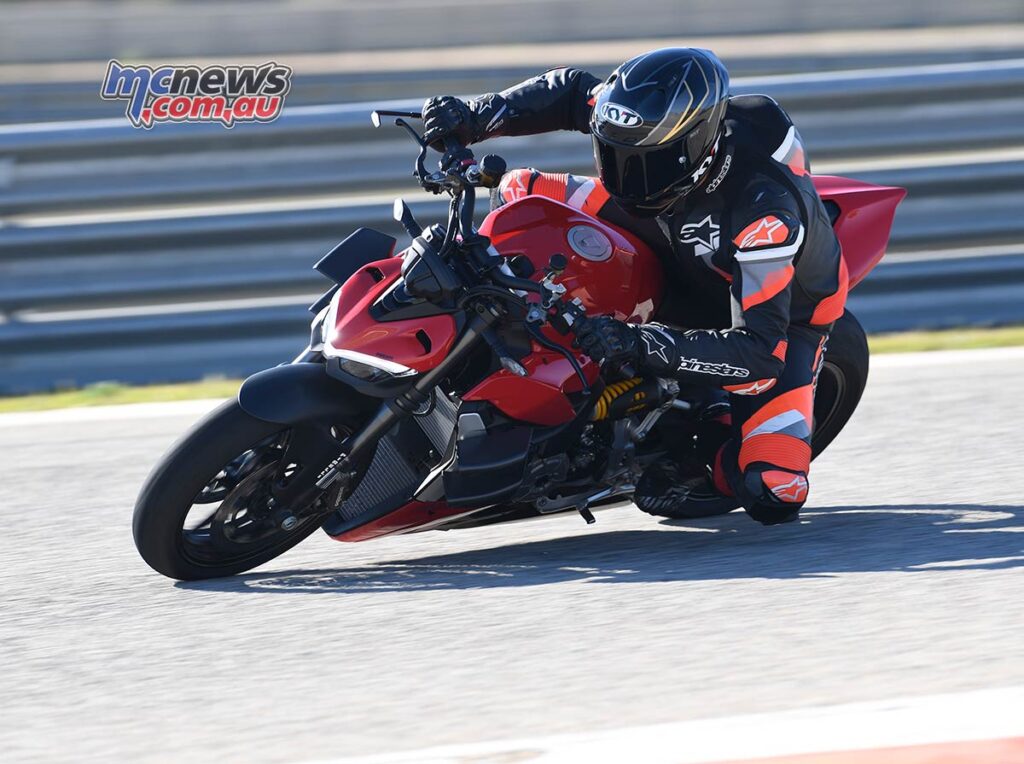
With a claimed 153 hp on tap—although a shorter final drive ratio delivers more torque to the rear wheel between 6-10,000 rpm compared to the Panigale—there’s plenty of performance but it never feels like it’s going to bite you.
There’s still enough to keep you on your toes, however, and with the ECU set to Sport mode there’s a definite kick in the power delivery once you surge through 5000 rpm and into the sixes. Below 4000 rpm, the power is docile and easy going, but get it past 6000 rpm and the switch gets flicked. You’re then in the zone, throwing gears at it and watching as the needle hovers around the 10,000 rpm mark. It’ll rev to 11,000 rpm, but meaningful drive was done about 600 rpm before that mark was hit, and you don’t want to go crashing into the hard-action rev limiter, trust me…
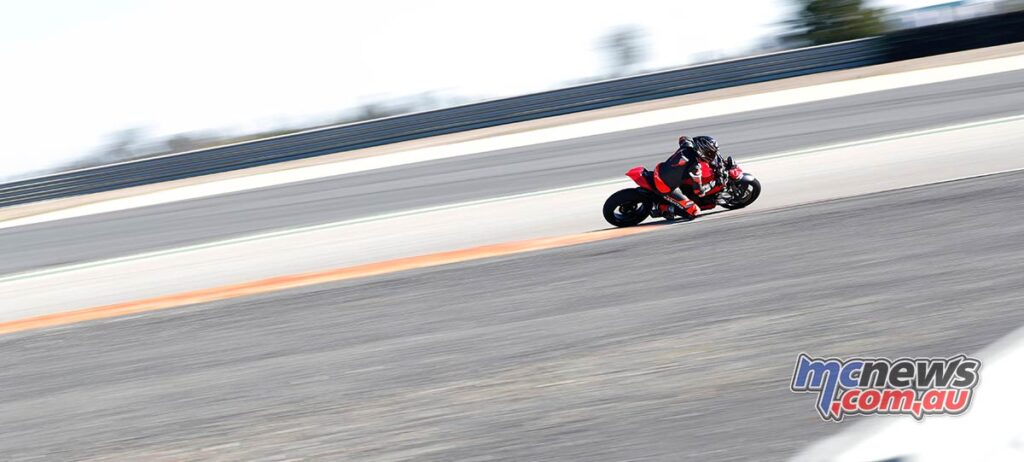
It’s best to keep the motor singing between 7-10,000 rpm as here’s where the money is. Clicking fourth, fifth gear, you’re greeted with oodles of power and it’s mated to one of the most agile chassis around. In fact, you wouldn’t want much more agility than this because you’ll start to sacrifice the stability, but Ducati has done well (especially test rider Alessandro Valia) to keep this in the forefront of the design ethos.
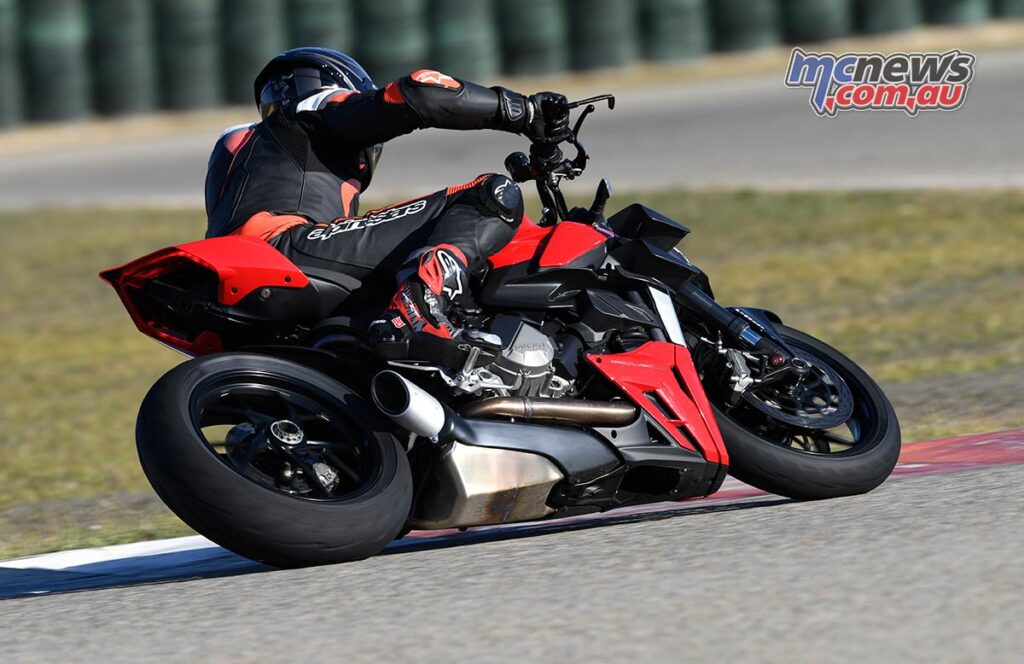
The Showa 43 mm BPF is a good fork but it’s not top-level Ohlins stuff, and at 89 kg without gear it and the shock were too soft me. I’d want to go up a spring if I were mainly using this for the track, but when switching to the road, this is where the Streetfighter really shines.
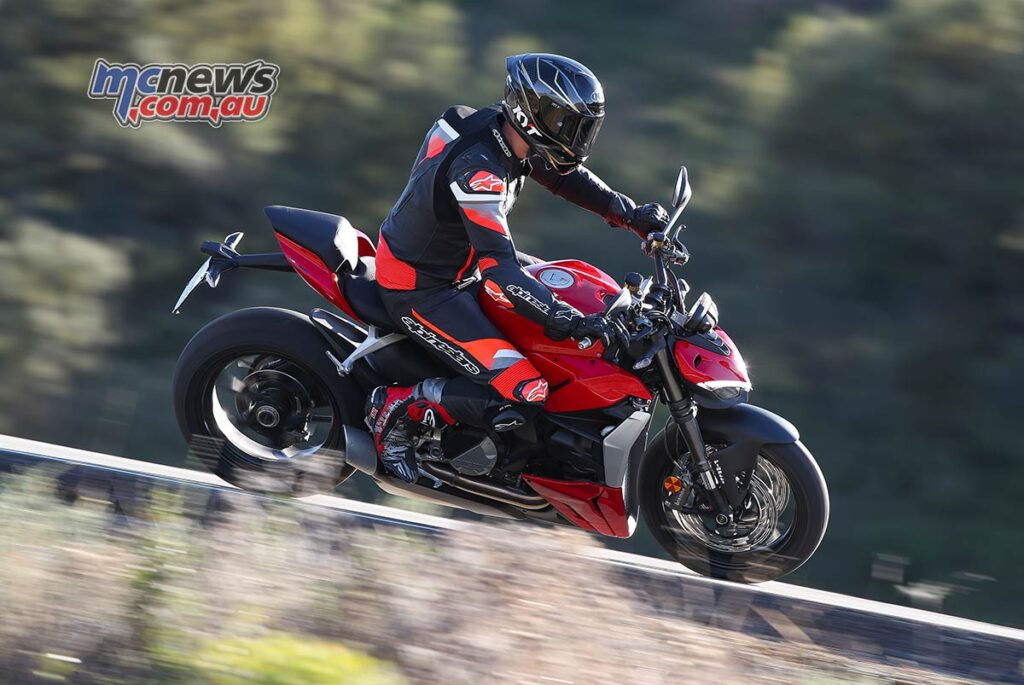
Putting the throttle map into the Road setting revealed a much more pleasant throttle response with the kick at 6000 rpm largely negated. It’s almost a case of the Streetfighter truly becoming one with its design when you take it away from apexes and start focusing on roads. The lack of wind protection you notice when you’re trying to max out every available ounce of performance on track isn’t as big a deal, and you can really enjoy the wide stance afforded by the one-piece handlebar.
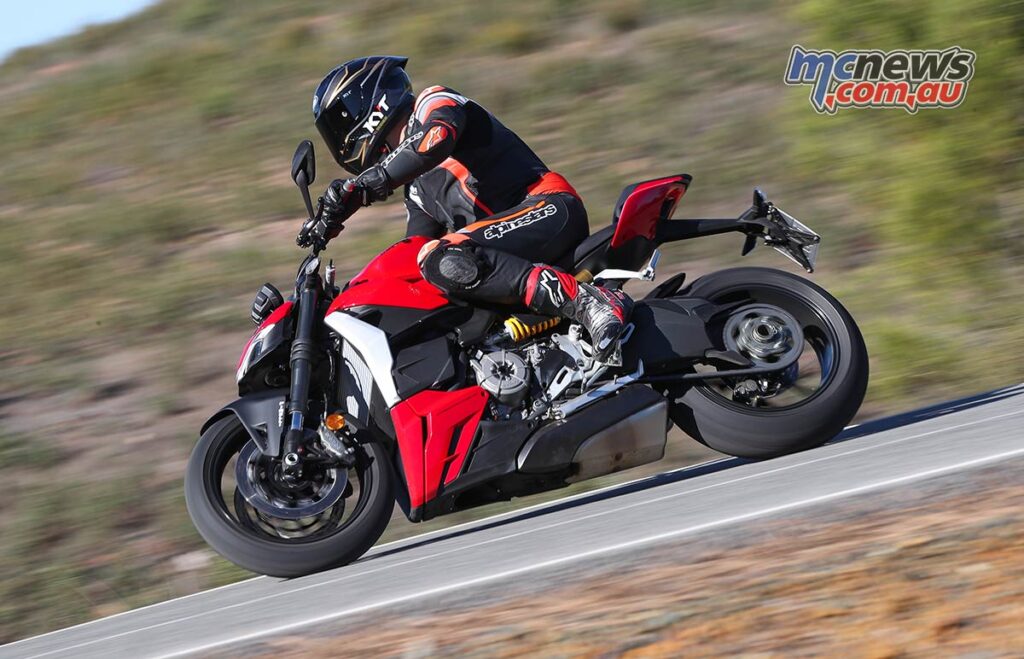
You sit on the Streetfighter rather than in it, the tank enveloping your knees nicely and your bum doesn’t go a numb as what it would be if you were on a Panigale V2.
Overall, it’s a comfortable ride on the street. This is a streetbike that can hold its own well enough on the track, but that’s not where its heart is. The combination of horsepower, throttle delivery in Road mode and the plush but not overly soft suspension on the road make for a great afternoon’s riding.
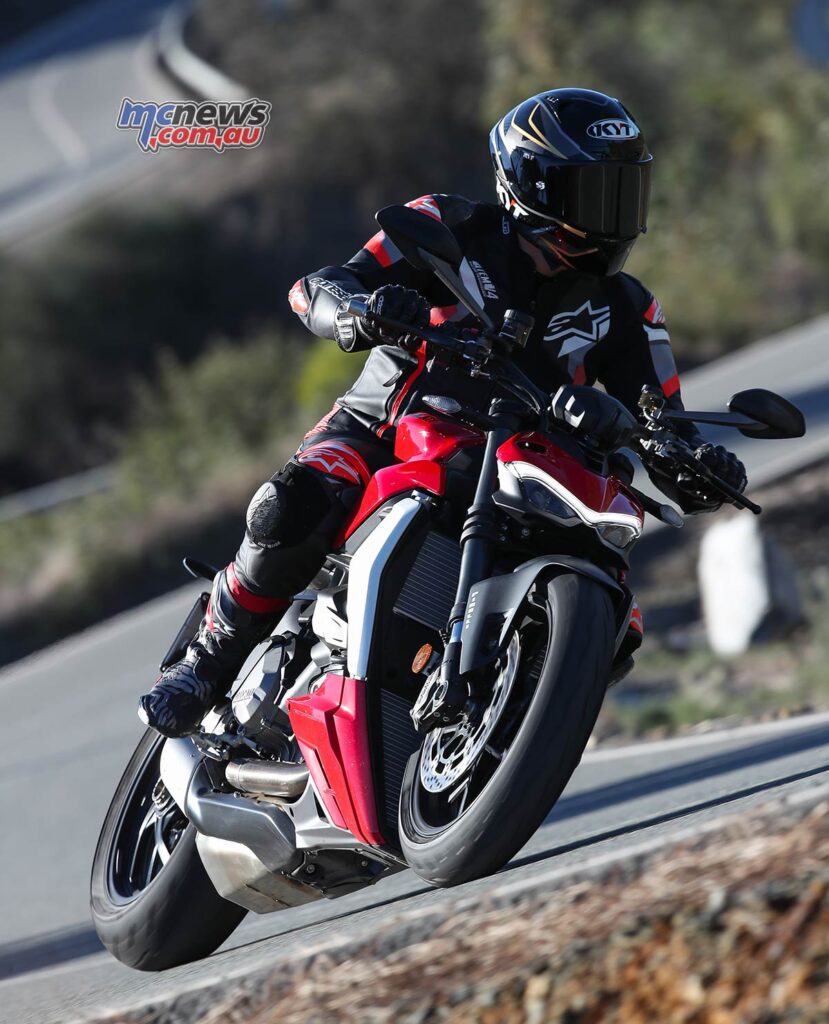
Combining all the virtues of the Streetfighters road and track manners has equalled a very good motorcycle indeed.
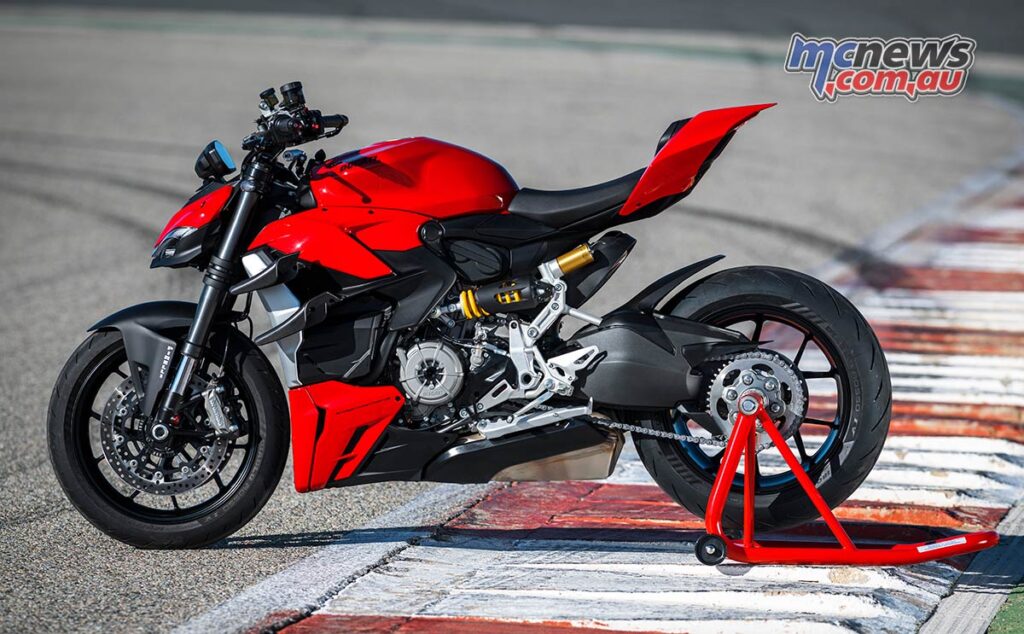
The Streetfighter V2’s arrival now completes the Ducati superbike/nakedbike and supersport/nakedbike family, and I feel with WorldSSP changing its rules to allow the Panigale V2 and one Mr. Bayliss Jnr on the grid next year, there’s going to be more attention paid to the 959 cc motor as a whole.
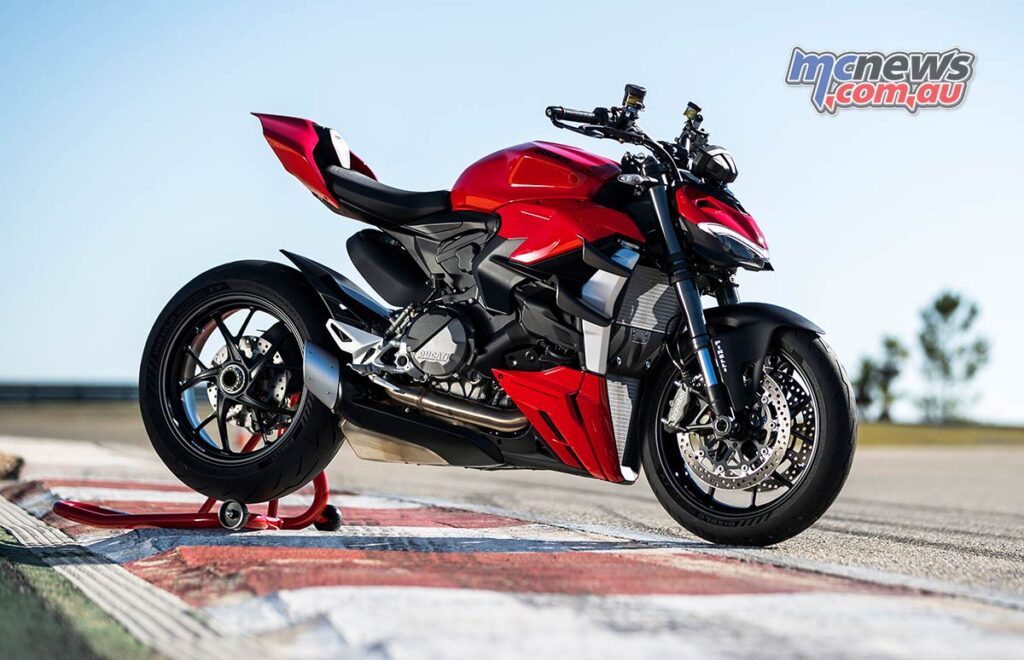
The 2022 Ducati Streetfighter V2 isn’t as mean as its bigger V4 brother, but that’s a good thing. Sometimes less really is more.
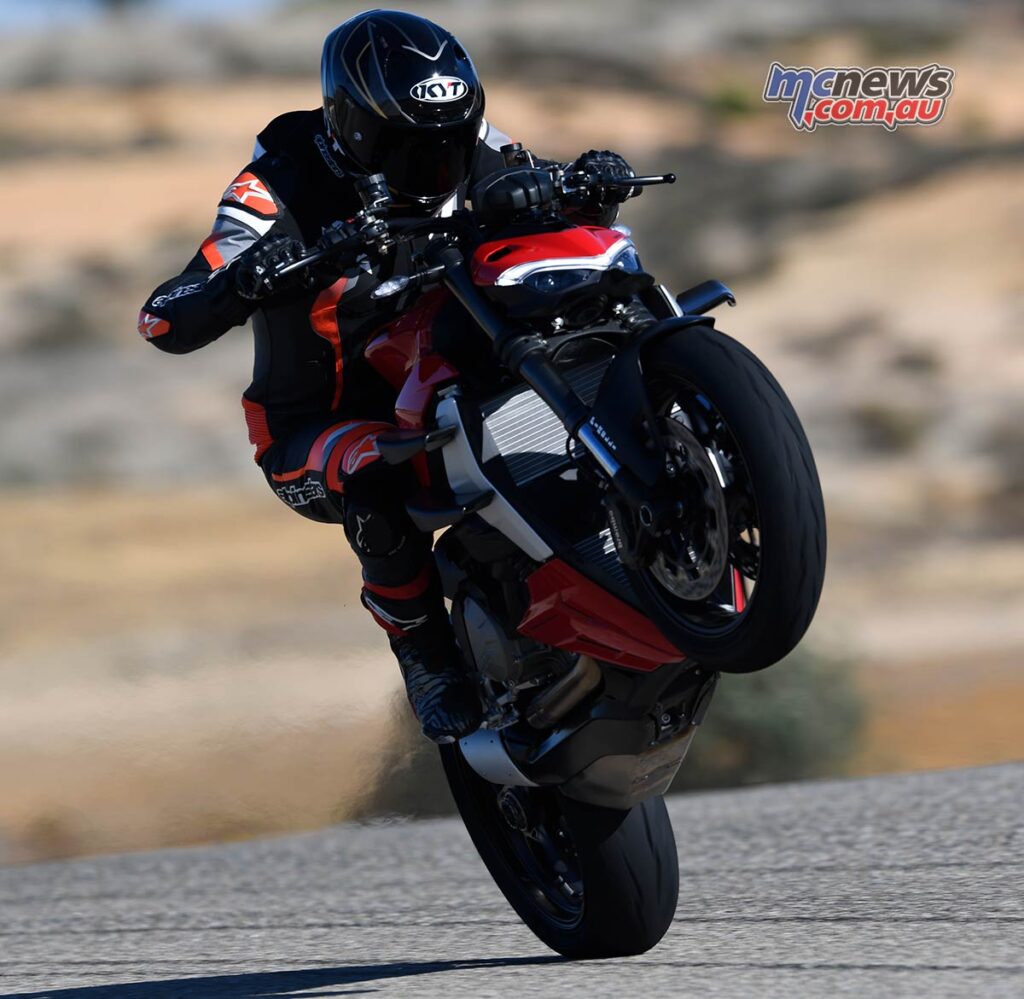
2022 Ducati Streetfighter V2 Specifications
| Engine | |
| Type | Superquadro: 90 ° V2, Desmodromic 4 valves per Cylinder, Liquid Cooled |
| Displacement | 955 cc |
| Bore X Stroke | 100 x 60,8 mm |
| Compression Ratio | 12.5:1 |
| Power | 112,3 kW (153 hp) @ 10.750 giri/min |
| Torque | 101,4 Nm (74,8 lb-ft) @ 9.000 rpm |
| Fuel Injection | Electronic fuel injection system. Twin injectors per cylinder. Full ride-by-wire elliptical throttle bodies |
| Exhaust | 2-1-2-1 System, With 2 Catalytic Converters And 2 Lambda Probes |
| Transmission | |
| Gearbox | 6 Speed With Ducati Quick Shift (DQS) Up/Down Evo 2 |
| Primary Drive | Straight cut gears; Ratio 1.77:1 |
| Ratio | 1=37/15 2=30/16 3=27/18 4=25/20 5=24/22 6=23/24 |
| Final Drive | Chain; Front sprocket 15; Rear sprocket 45 |
| Clutch | Hydraulically controlled slipper and self-servo wet multiplate clutch. Self bleeding master cylinder |
| Chassis | |
| Frame | Monocoque Aluminium |
| Front Suspension | Fully adjustable Showa BPF fork. 43 mm chromed inner tubes |
| Front Wheel | 5-spokes light alloy 3.50″ x 17″ |
| Front Tyre | Pirelli Diablo Rosso IV 120/70 ZR17M |
| Rear Suspension | Fully adjustable Sachs unit. Aluminum single-sided swingarm |
| Rear Wheel | 5-spokes light alloy 5,50” x 17” |
| Rear Tyre | Pirelli Diablo Rosso IV 180/60 ZR17M |
| Wheel Travel (Front/Rear) | 120 mm (4.72 in) – 130 mm (5.12 in) |
| Front Brake | 2 X 320 Mm Semi-Floating Discs, Radially Mounted Brembo Monobloc M4.32 4-Piston Callipers With |
| Rear Brake | 245 mm disc, 2-piston calliper with Bosch |
| Cornering ABS EVO | Bosch Cornering ABS EVO. Self Bleeding Master Cylinder |
| Instrumentation | Digital unit with 4,3″ TFT colour display |
| Dimensions And Weights | |
| Dry Weight | 178 kg (392 lb) |
| Kerb Weight* | 200 kg (441 lb) |
| Seat Height | 845 mm (33,3 in) |
| Wheelbase | 1.465 mm (57,7 in) |
| Rake /Trail | 24° 94 mm (3.70 in) |
| Fuel Tank Capacity | 17 l – 4.5 gallon (US) |
| Number Of Seats | 2 |
| Equipment | |
| Safety Equipment | Riding Modes, Power Modes, Bosch Cornering |
| ABS EVO, Ducati Traction Control (DTC) EVO 2, | |
| Ducati Wheelie Control (DWC) EVO, Engine Brake | |
| Control (EBC) EVO, Auto tyre calibration | |
| Ducati Quick Shift (DQS) up/down EVO 2, Full | |
| Standard Equipment | LED lighting with Daytime Running Light (DRL), |
| Sachs steering damper, Auto-off indicators | |
| Ducati Data Analyser+ (DDA+) with GPS module, | |
| Ready For | Ducati Multimedia System (DMS), Ducati LinkApp, Anti-theft |
| Warranty And Maintenance | |
| Warranty | 24 months unlimited mileage |
| Maintenance Service Intervals | 12,000 km (7,500 mi) / 12 months |
| Valve Clearance Check | 24,000 km (15,000 mi) |
| RRP | $22,500 Ride Away |


